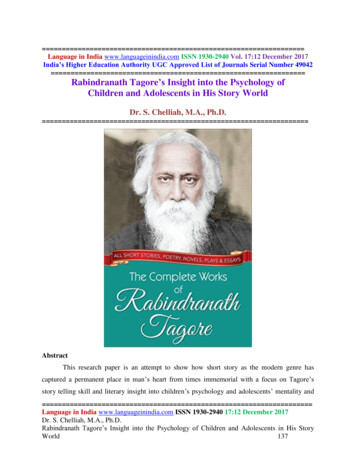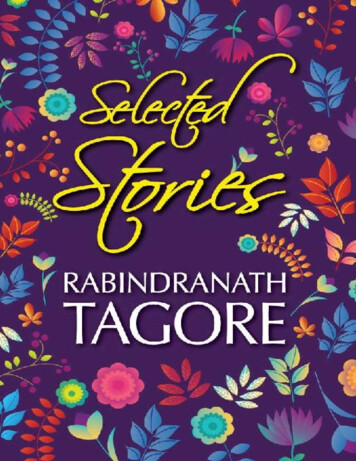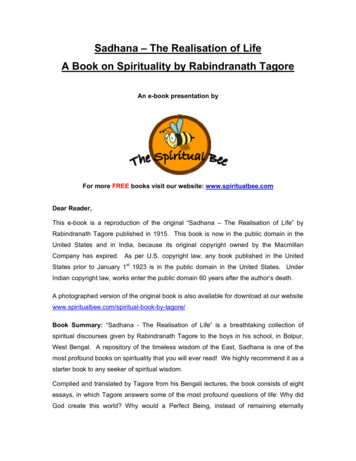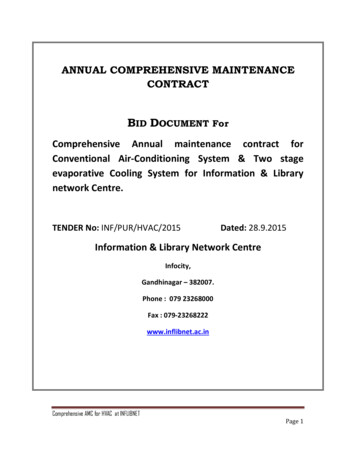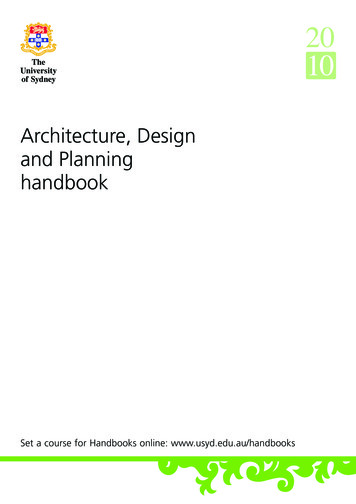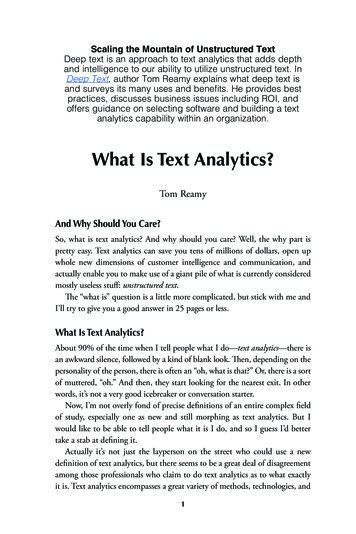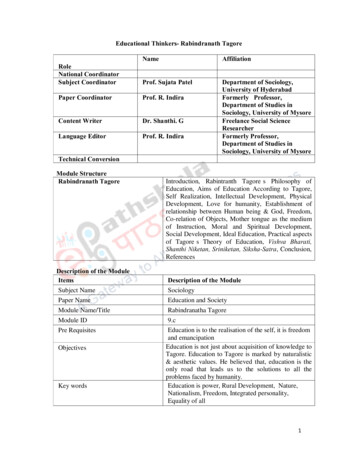
Transcription
Educational Thinkers- Rabindranath TagoreNameAffiliationRoleNational CoordinatorSubject CoordinatorProf. Sujata PatelPaper CoordinatorProf. R. IndiraContent WriterDr. Shanthi. GLanguage EditorProf. R. IndiraDepartment of Sociology,University of HyderabadFormerly Professor,Department of Studies inSociology, University of MysoreFreelance Social ScienceResearcherFormerly Professor,Department of Studies inSociology, University of MysoreTechnical ConversionModule StructureRabindranath TagoreIntroduction, Rabintranth Tagore’s Philosophy ofEducation, Aims of Education According to Tagore,Self Realization, Intellectual Development, PhysicalDevelopment, Love for humanity, Establishment ofrelationship between Human being & God, Freedom,Co-relation of Objects, Mother tongue as the mediumof Instruction, Moral and Spiritual Development,Social Development, Ideal Education, Practical aspectsof Tagore’s Theory of Education, Vishva Bharati,Shanthi Niketan, Sriniketan, Siksha-Satra, Conclusion,ReferencesDescription of the ModuleItemsDescription of the ModuleSubject NameSociologyPaper NameEducation and SocietyModule Name/TitleRabindranatha TagoreModule ID9.cEducation is to the realisation of the self, it is freedomand emancipationEducation is not just about acquisition of knowledge toTagore. Education to Tagore is marked by naturalistic& aesthetic values. He believed that, education is theonly road that leads us to the solutions to all theproblems faced by humanity.Education is power, Rural Development, Nature,Nationalism, Freedom, Integrated personality,Equality of allPre RequisitesObjectivesKey words1
Rabindranath Tagore“The regular type of school is a manufactory and is a mere method of discipline speciallydesigned for grinding out uniform results” Rabindranath TagoreIntroductionRabindranath Tagore, recipient of the Nobel Prize for Literature in 1913, isinternationally known as a great poet. He was born in the year 1861, in Calcutta, Bengal. Hismother was Sarala Devi and father Maharsi Devendranath. Maharsi Devendranath was astudent of Indian and Islamic mysticism. From his earliest days, Rabindranath grew up in ahouse where all the changes emerging in Indian society of that time were being felt in hisday-to-day life. In Bengal, this change more often known as Renaissance, found expressionin three great movements, religious, literary and national and all these three movementsfound their votaries in the Tagore family. In an atmosphere like this Tagore himself startedwriting poems at the age of eight and at the age of thirteen his poems were published in aBengali monthly magazine, Bharati, under the name of Bhanusimha /tagorehiseducati00jala djvu.txt).Rabindranath's poetic career culminated in his book Gitanjali, for which he wasawarded the Nobel Prize. Actually his fame as a poet has eclipsed his great contributions toeducation. Although Tagore's literary versatility as a poet, dramatist, short-story writer,essayist, and novelist has received wide attention in his home country, his educational theoryand practice have been neglected for the most part. Tagore did not have any academic degreein education, but he was a great educator of his time. He not only advocated changes ineducation but practiced them in his school at Shantiniketan. The school started in 1901, waslater expanded and named Visva-Bharati, the International University. Visva-Bharati2
introduced the Department of Rural Welfare with the name Sriniketan. Sriniketan emergedas a centre of rural reconstruction and village education. Tagore is a pioneering educationalthinker who could put into practice the principles of a holistic and realistic education. Todayit is considered as a very revolutionary and progressive educational theory, even though notpracticed by many. At present, when India is trying to find appropriate educational directionfor its development, Tagore's treatise on education needs to be revisited.Philosophy of EducationTagore, laid great stress and emphasis on the aesthetic development of the senses inhis philosophy of education. He argued that development of the senses was as important asintellectual development. He therefore gave prominence to music, literature, art, dance, anddrama in the daily life of the school. Tagore believed in an all round development ofpersonality and in his institution education continues to address the all round development ofthe students.Tagore's theory of education is marked by naturalistic & aesthetic values. He had abelief that "The widest road leading to the solution of all our problems is education."Education can develop a new pattern of life which culminates in the realisation of Universalman. Tagore's system of education emphasises the intellectual, physical, social, moraleconomic and spiritual aspects of human life by which a man can develop an 9110/Rabindranath Tagore on Education).Tagore believed that along with education, economic upliftment is also necessary.Since economic life covers the whole width of the fundamental basis of society because itsnecessities are the simplest and the most universal, he suggested that educationalinstitutions, in order to obtain their fullness of truth, must have close associations with thiseconomic life. “Our university must not only instruct, but live; not only think, but ti00jala/tagorehiseducati00jala re-quotes-life/)3
Aims of EducationTagoer’s views on education and its aims are reflected in the goals of Shantiniketanan educational institution founded by him. The aims of education according to him are asfollows:Self RealisationSpiritualism is the essence of humanism, this concept has been reflected in Tagore'seducational philosophy. Self-realisation is an important aim of education. Manifestation ofpersonality depends upon the self-realisation and spiritual knowledge of an individual.Intellectual DevelopmentTagore also greatly emphasised the intellectual development of the child. Byintellectual development he means development of imagination, creative free thinking,constant curiosity and alertness of the mind. Children must be free to adopt their own ways oflearning which would lead to all round development.Physical DevelopmentTagore's educational philosophy also aims at the physical development of the child.He gave much importance to a sound and healthy physique. There were different kinds ofexercises, such as Yoga, games and sports prescribed in Shantiniketan as an integral part ofthe education system.Love for HumanityTagore held that the entire universe is one family. Education can teach people torealize the oneness of the globe. Education for international understanding and universalbrotherhood is another important aim of his educational philosophy. The feeling of onenesscan be developed through concepts like fatherhood of God and brotherhood of human beings.In other words all beings are equal.Establishment of Relationship between Man and GodTagore noted that human beings possess different qualities and potentialities that arebestowed by God. These qualities are inborn and innate. Hence, the relationship betweenhuman beings and God is strong and permanent. However the dedication to spiritualism andsacredness will lead to a harmonious relationship between man, nature and God.FreedomFreedom according to Tagore is an integral aspect of human development. Educationis a personality building process; it explores the innate power that exists within all humanbeings. It is not an imposition, but a liberal process that provides utmost freedom to4
individuals for their all round development. He says, “Education has learning only when it isimparted through the path of freedom"(https://archive.org/stream/ tagorehiseducati00jala/tagorehiseducati00jala djvu.txt).Co-relation of ObjectsTagore noted that there exists a co-relation between God, man and nature. A peacefulworld is only possible only when this co-relation is established between man and nature.Mother tongue as the Medium of InstructionTagore very strongly believed that the language is the true vehicle of self-expression.People can freely express their thoughts in their mother-tongues. Tagore has emphasised thatmother tongue must serve as medium of instruction for a child's education.Moral and Spiritual DevelopmentTagore emphasised moral and spiritual training in his educational thought. Moral andspiritual education is more important than bookish knowledge for an integral development ofhuman personality. There must be an adequate provision for the development of selflessactivities, co-operation and love, fellow feeling and sharing among the students ineducational institutions.Social DevelopmentAccording to Tagore, "Brahma" the supreme soul manifests himself through humanbeings and other creatures. Since ‘He’ is the source of all human-beings and creatures, all areequal. Rabindranath Tagore therefore said, "service to man is service to god". Every humanbeing must develop social relationship and fellow-feeling from the beginnings of one's life.Education aims at developing the individual personality as well as social characters whichenables them to live as worthy beings (https://www. academia.edu/ 4659110/RabindranathTagore on Education).It emerges from an understanding of the goals of education as enunciated by Tagorethat he stressed on the emancipation of the soul more than the ‘body’ or ‘mind’. "For us tomaintain our self- respect which we owe to ourselves and to our Creator, we must make thepurpose of our education. . .the fullest growth and freedom of soul”. For the attainment ofthis aim, he emphasized on intellectual, physical, moral and social development of /Bo-Tree/people/PeopleVol.03 P032012 web.pdf ; Mondal et al, 2014.)5
Ideal EducationIn many works of Tagore, he has discussed what according to him ideal educationis. He references to ideal education as one that covers an ideal atmosphere, institution,teacher, and method. While discussing Tagore's educational ideals, Alex Aronson (1978)noted that the perfect education given to a child should, therefore, be like the perfect poem:self contained, unified, and controlled by the ever-recurring rhythm of natural growth fromchildhood to adulthood.To Tagore it was not the formal method of teaching, which was the most importantpart of an ideal education, but it was the environment which surrounded the educationalpattern. He believed that it is absolutely necessary to cater to the mental health and overallgrowth of children rather than merely teaching within four walls. Tagore noted that what ismore important is a world whose guiding spirit is personal love. It must be an ashram wheremen have gathered for the highest end of life, in the peace of nature, where life is not merelymeditative, but fully awake in its activities. It is due to this that any description of such aschool would be inadequate. It is not some place which can be described in terms of fixedrules and regulations or curriculum. Here children live in an atmosphere of culture, and donot feel that the school is an imposition. Education is no longer instruction, but it is a processof inspiration and a joyous but slow absorption (Tagore. 1929).Similarly, an ideal institution, in Tagore’s view, should provide children with thefirst important lesson of "improvisation" and with "constant occasions to explore one'scapacity through surprises of achievement." There is no place for constant imposition ofready-made ideas and knowledge. Tagore advocated a creative middle path between workand asceticism. This middle path is the path of self-realization or Sadhana and this part hasbeen emphasised most in Tagore's ideal institution (https://www. academia.edu/4659110/Rabindranath Tagore on Education, ucati00jala/tagorehiseducati00jala djvu.txt).Tagore noted that ‘Ideal education can be imparted only by ideal teachers’.According to Tagore the greater part of our learning in schools has been wasted because, formost of our teachers, their subjects are like dead specimens of once-living things with whichthey have a learned acquaintance, but no communication of life and love. The teacher whomerely repeats bookish knowledge mechanically can never teach anything and can neverinspire, and without proper inspiration independent creative faculties can never develop(Tagore. 1929).6
Thus, true education, he asserts, develops the power of self-reliance, the ability todo without materials and the machine. The ideal of the Ashram education, which headvocated was education for life at its fullest. His idea was to train young men and women infreedom and strength, in courage and service. According to Tagore, books make the mindlazy. The child should be exposed to an atmosphere of creativity and learning, to a world ofexperiences. For the first twelve years we must educate the child's mind along the line of itsown natural tendencies and instincts and only then, at twelve years old, introduce the books"(Tagore. 1929). He never believed in compulsion, but tried to give the best side of humannature a chance to show itself. Everything in the school he left to the initiative of the pupils,though they were always in close touch with their elders. The primary object of an institutionshould not be merely to educate one's limbs and mind to be in efficient readiness for allemergencies (Tagore. 1929).Tagore's Experiments with Educational Theory and PracticeTagore's educational theory was found practical expressions in his school atShantiniketan. In December 1901, an experimental school known as Brahmacharyashramwas started by Rabindranath with only five students on roll. The founding of the school waspart of the education in fullness. Beginning with his own unhappy memory of school, whichhe described as a blend of hospital and gaol, he concentrated on children and emphasizedcreativity, the need for atmosphere and natural surroundings. The aim was neither ascetic norrevivalistic but integrative. Tagore notes that his initial efforts drew comments such as “anoutcome of his poetic fancy”, "something outrageously new being the product of daringexperience" (Tagore, 1917q, p. 137). Nevertheless, he succeeded in gathering around him aband of selfless workers and the management of the school was carried on along simpledemocratic lines through a committee almost entirely elected by the staff. Education wasentirely free. The curriculum included English, Bengali, Sanskrit, Arithmetic, History,Geography, and Science. All work like housekeeping, gardening, except cooking, had to bedone by the pupils themselves. Life was simple, regular and austere and was inspired by theideals of hospitality, self-help and respect for the elders /tagorehiseducati00jala djvu.txt). Life in the midst of nature he believed,equips each pupil to imbibe the values of appreciation of the nature its sustenance, co-livingand respect for multi-cultural components of human society. The learning was based on selfexperiencing of the universe around us and drawing intensely from it. In the play hours in theevenings in his schooling method, each student has to spend in story-telling, watching the7
stars, singing, and performing plays. These songs and plays most of the time wereencouraged to be written by students themselves. Learning was made fun and the choice ofthe child. This approach to learning helped many students to come to his experimental schoolrather than discontinue. A school which began with less than 10 students had 150 on rolls in ashort span of time. This increase in student population necessitated immediate extension ofschool buildings and expansion of grounds and facilities. In 1908 the girls' section was added.Although according to the syllabus prescribed textbooks had to be studied in thematriculation classes, stereotyped textbooks were discarded and general reading wasencouraged. Thorough attention was paid to the health of the students. Games and gardeningwere compulsory. Though the school unfairly enough enjoyed the unenviable reputation ofbeing an exile for problem children, corporal punishment was prohibited on principle andvery seldom actually resorted to.From 1919, arrangements were made for providing courses of higher studies inBuddhist literature, Vedic and Classical Sanskrit, Pali, Prakrit and later on Tibetan, Chinese,Jain, Zoroastrian and Islamic studies. Tagore had already introduced the teaching of art andmusic, and now, Kala Bhavan (School of Art and Music) was established at Visva- i00jala/tagorehiseducati00jala djvu.txt,https://www. academia.edu/ 4659110/Rabindranath Tagore on Education).Viswa-BharatiThe idea of establishing a center of learning where not only the East but the wholeworld would meet in cultural communion took a more definite shape during his tour offoreign countries immediately after World War I. The name Visva-Bharati came intoexistence in 1921. Since then Shantiniketan has been the seat of Visva-Bharati - aninternational university, seeking to develop a basis on which the cultures of the East and theWest may meet in common fellowship with a motto “Yatra Visvam Bhavatyekanidam”, ie.,“where the world makes its home in a single nest”. Visva-Bharati as a whole, aimed atestablishing a living relationship between the East and the West, promoting inter-racial amityand inter-cultural understanding and fulfilling the highest mission of the present age - theunification of mankind.The school went through innumerable experimental changes and finally emerged intwo parts namely, Vidya Bhavan, which concentrated mainly on research work and studies ofdifferent eastern cultures, and Siksha-Bhavan, which imparted collegiate education up to thegraduation level. The music and art sections were separated in 1934 and the music sectionbecame the Sangeet Bhavana, while the art section retained its old name, Kala Bhavana. In8
the late thirties, two more departments, Cheena-Bhavana and Hindi Bhavana wereestablished with endowments for Chinese and Hindi studies. After Rabindranath Tagore’sdeath in 1941, Rabindra- Bhavana was established in July 1942, as a Research Academy andMemorial Museum. In 1948, another department, Vinaya-Bhavana, was established under thebasic education training scheme. In May 1951, four years after independence of India, VisvaBharati was declared to be an institution of national importance and was incorporated as aunitary teaching and residential university by Act XXIX of 1951 of the Indian cati00jala/tagorehiseducati00jala nath Tagore on Education).SriniketanAny description of Visva-Bharati is incomplete without Sriniketan. Tagore believedthat an important part of the work of a university should be to gather accurate knowledgeabout rural conditions, their practices related to various aspects of life in general andagriculture and economy and social issues in particular and also their tribulations related tothe life situations. He wanted the knowledge acquired by the students and research groups beused to solve the issues and problems faced by rural communities. To Tagore, the word "Sri"in Sriniketan stood for prosperity. The name Sriniketan therefore reveals Tagore's hope tomake it a center where rural development related knowledge would be developed based onthe inputs at grass-roots level and also to bring more authentic scientific knowledge to ruralcommunities so that the lives of these people could be more meaningful, thus leading toprosperity and welfare of villages.Sriniketan was started with two main objectives. First, to understand the economicand social needs of the cultivators and second, to extend the scientific knowledge available inareas like health, education, agricultural practices, animal husbandry and craft. Accordingly,the activities of Sriniketan were organized under four departments: (1) Agriculture, includingAnimal Husbandry, (2) Industries, (3) Village Welfare, and (4) Education, and the unifiedprogram was given the name of Institute of Rural Reconstruction "Palli Samgathan Vibhaga"(https://www. academia.edu/ 4659110/Rabindranath Tagore on Education, Tagore.1929,https://archive.org/stream/ tagorehiseducati00jala/ tagorehiseducati00jala djvu .txt).Siksha-SatraTagore’s philosophy further translated into action when he established a highschool, Siksha-Satra, mainly for rural children in Sriniketan. This is apart the educationalactivities of the Village Welfare Department. The school is organised as a miniaturecommunity and students do everything that a village householder is expected to do, on a9
small scale but with greater efficiency and understanding. The literary education is notignored but more attention is given to building up of the complete human being. The extracurricular activities of the Siksha-Satra included: (1) Industry (weaving, carpentry, bookbinding and leather works), (2) Gardening, (3) Health and sanitation, (4) Housecraft andgeneral management, (5) Sports, games and Brati-Balaka activities, (6) Educational trips toplaces of interest, (7) Literary society, (8) A monthly manuscript magazine - Chesta (Effort).Siksha-Charcha Bhavana - Educational activities at Sriniketan also included a training schoolfor teachers of village primary school which is known as Siksha-Charcha. It providesinstruction in both theory and practice for teachers. Practical training in one village craft isconsidered essential.After Tagore's death a new department was added in Sriniketan. This was the PalliSiksha Sadana, a College of Agriculture. It was designed primarily to equip rural youth withthe knowledge of modern methods of farming. Besides, instruction in basic sciences likeChemistry, Physics, Mathematics, Botany and Zoology, it also provides specialised coursesin Agronomy, Goat Keeping, Agricultural Economics, Agricultural Chemistry, Horticulture,Entomology, Agricultural Engineering, Plant Pathology, Genetics, Plant Breeding and FarmManagement. Practical training in agriculture and dairy farms and field work are integralelements of the course /tagorehis educati00jala djvu.txt, https://www.academia.edu/4659110/Rabindranath Tagore on Education).Educational Contributions of TagoreTo understand Tagore’s contributions to education one must glean through hisvarious writings and educational experiments at Santiniketan. This is mainly due to the factthat Tagore did not write an educational treatise. We understand his thoughts on educationevolved gradually with many experiments and his exposure to different schooling methodsacross the globe. He envisioned an education that was deeply rooted in one’s immediatesurroundings but connected to the cultures of the wider world, predicated upon pleasurablelearning, individualised to the personality of the child. He felt that a curriculum shouldrevolve organically around nature with classes held in the open air under the trees to providefor a spontaneous appreciation of the fluidity of the plant and animal kingdoms, and seasonalchanges. Children sat on hand-woven mats beneath the trees, which they were allowed toclimb and run beneath between classes. Nature walks and excursions were a part of thecurriculum and students were encouraged to follow the life cycles of insects, birds andplants. Class schedules were made flexible to allow for shifts in the weather or special10
attention to natural phenomena, and seasonal festivals were created for the children byTagore (https://archive.org/stream/ tagorehiseducati00jala/ tagorehiseducati00jala djvu.txt).Tagore's philosophy of education placed equal importance on the aestheticdevelopment of the senses along with the intellectual. To him music, literature, art, danceand drama were very important aspects of daily school life. Without music and the fine arts,he wrote, a nation lacks its highest means of national self-expression and the people remaininarticulate. Tagore was one of the first to support and bring together different forms ofIndian dance. He helped revive folk dances and introduced dance forms from other parts ofIndia, such as Manipuri, Kathak and Kathakali. He also supported modern dance.In keeping with his theory of subconscious learning, Tagore engaged the students inwhatever he was writing or composing. The students were allowed access to the room wherehe read his new writings to teachers and critics, and they were encouraged to read out theirown writings in special literary evenings. In teaching also he believed in presenting difficultlevels of literature, which the students might not fully grasp, but which would stimulatethem. The students at Shantiniketan were encouraged to create their own publications andput out several illustrated magazines. The children were encouraged to follow their ideas inpainting and drawing and to draw inspiration from the many visiting artists and writers(https://www. academia.edu/ 4659110/Rabindranath Tagore on Education).The melting point of cultures, as Tagore had envisioned it at Visva-Bharati, alearning centre where conflicting interests are minimized , where individuals work togetherin a common pursuit of truth and realise 'that artists in all parts of the world have createdforms of beauty, scientists discovered secrets of the universe, philosophers solved theproblems of existence, saints made the truth of the spiritual world organic in their own lives,not merely for some particular race to which they belonged, but for all mankind.'To encourage mutuality, Tagore invited artists and scholars from other parts of Indiaand the world to live together at Shantiniketan on a daily basis to share their cultures withVisva-Bharati. The Constitution designated Visva-Bharati as an Indian, Eastern and Globalcultural centre whose goals were to:1. Study the mind of Man in its realisation of different aspects of truth from diversepoints of view.2. Bring into more intimate relation with one another through patient study and research,the different cultures of the East on the basis of their underlying unity.3. Approach the West from the standpoint of such a unity of the life and thought of Asia.11
4. Seek to realise in a common fellowship of study the meeting of East and West andthus ultimately strengthen the fundamental conditions of world peace through the freecommunication of ideas between the two hemispheres.5. And with such Ideals in view to provide at Shantiniketan a centre of culture whereresearch into the study of the religion, literature, history, science and art of Hindu,Buddhist, Jain, Zoroastrian, Islamic, Sikh, Christian and other civilisations may bepursued along with the culture of the West, with that simplicity of externals which isnecessary for true spiritual realisation, in amity, good-fellowship and co-operationbetween the thinkers and scholars of both Eastern and Western countries, free from allantagonisms of race, nationality, creed or caste and in the name of the One SupremeBeing who is Shantam, Shivam, Advaitam (O’Connell, K. M. (2003).In terms of curriculum, Tagore advocated a different methodology of teaching.Rather than studying national cultures for the wars won and cultural dominance imposed, headvocated a teaching system that analysed history and culture for the progress that had beenmade in breaking down social and religious barriers. Rabindranath Tagore is acknowledgedas a living icon of the type of mutuality and creative exchange that he advocated.Tagore's educational efforts were ground-breaking in many areas. He was one of thefirst in India to argue for a humane educational system that was in touch with theenvironment and aimed at overall development of the personality. Shantiniketan became amodel for vernacular instruction and the development of Bengali textbooks; as well, itoffered one of the earliest coeducational programs in South Asia. The establishment ofVisva-Bharati and Sriniketan led to pioneering efforts in many directions, including modelsfor distinctively Indian higher education and mass education, as well as pan-Asian andglobal cultural exchange.One characteristic that sets Rabindranath Tagore's educational theory apart is hisapproach to education as a poet. At Shantiniketan, he stated, his goal was to create a poem'in a medium other than words.' It was this poetic vision that enabled him to fashion ascheme of education which was all inclusive, and to devise a unique program for educationin nature and creative self-expression in a learning climate congenial to global culturalexchange.Summing UpRabindranath Tagore, stands with the pioneering educators, like, Rousseau,Pestalozzi, Froebel, Montessori and Dewey Malcolm Knowles, who have striven to createnon-authoritarian learning systems appropriate to the surroundings(O’Connell, K. M. (2003).12
Tagore’s ideas of non-authoritarian learning and goals for international education is bestunderstood through his poem he writes:“Where the mind is without fearand the head is held high,where knowledge is free.Where the world has not been broken up into fragments by narrow domestic walls.Where words come out from the depth of truth,where tireless striving stretches its arms toward perfection.Where the clear stream of reason has not lost it's wayinto the dreary desert sand of dead habit.Where the mind is led forward by theeinto ever widening thought and action.In to that heaven of freedom, my father,LET MY COUNTRY AWAKE!”― Rabindranath Tagore, Gitanjali: Song Offerings“The highest education is that which does not merely give us information but makes our
rules and regulations or curriculum. Here children live in an atmosphere of culture, and do not feel that the school is an imposition. Education is no longer instruction, but it is a process of inspiration and a joyous but slow absorption (Tagore. 1929). Similarly, an ideal institution, in Tagore's view, should provide children with the
